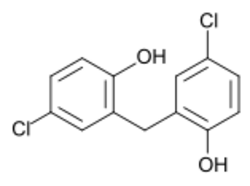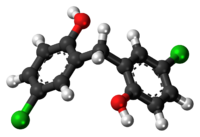Chemistry:Dichlorophen
From HandWiki
Short description: Chemical compound
 | |
 | |
| Clinical data | |
|---|---|
| AHFS/Drugs.com | International Drug Names |
| ATC code | |
| Identifiers | |
| |
| CAS Number | |
| PubChem CID | |
| ChemSpider | |
| UNII | |
| KEGG | |
| ChEMBL | |
| Chemical and physical data | |
| Formula | C13H10Cl2O2 |
| Molar mass | 269.12 g·mol−1 |
| 3D model (JSmol) | |
| Density | 1.5 g/cm3 g/cm3 |
| Melting point | 177.5 °C (351.5 °F) |
| Solubility in water | 0.003 g/100 mL[1] mg/mL (20 °C) |
| |
| |
| | |
Dichlorophen is an anticestodal agent, fungicide, germicide, and antimicrobial agent.[2] It is used in combination with toluene for the removal of parasites such as ascarids, hookworms, and tapeworms from dogs and cats.[3]
Safety and regulation
LD50 (oral, mouse) is 3300 mg/kg.[4]
References
- ↑ Handbook of Chemistry and Physics (87 ed.). Boca Raton, Florida: CRC Press. 1998. pp. 8–118. ISBN 0-8493-0594-2.
- ↑ Milne, G.W.A. (Ed.). (2005). Gardner's commercially important chemicals: Synonyms, trade names, and properties. Hoboken, N.J.: Wiley-Interscience. Google Books
- ↑ "Code of Federal Regulations", Code of Federal Regulations, Title 21, Volume 6 (U.S. Government Printing Office), 2005-04-01, http://frwebgate1.access.gpo.gov/cgi-bin/TEXTgate.cgi?WAISdocID=220114194717+2+1+0&WAISaction=retrieve, retrieved 2009-05-01
- ↑ "Ullmann's Encyclopedia of Industrial Chemistry". Ullmann's Encyclopedia of Industrial Chemistry. Weinheim: Wiley-VCH. 2007. doi:10.1002/14356007.a19_313.
 |

